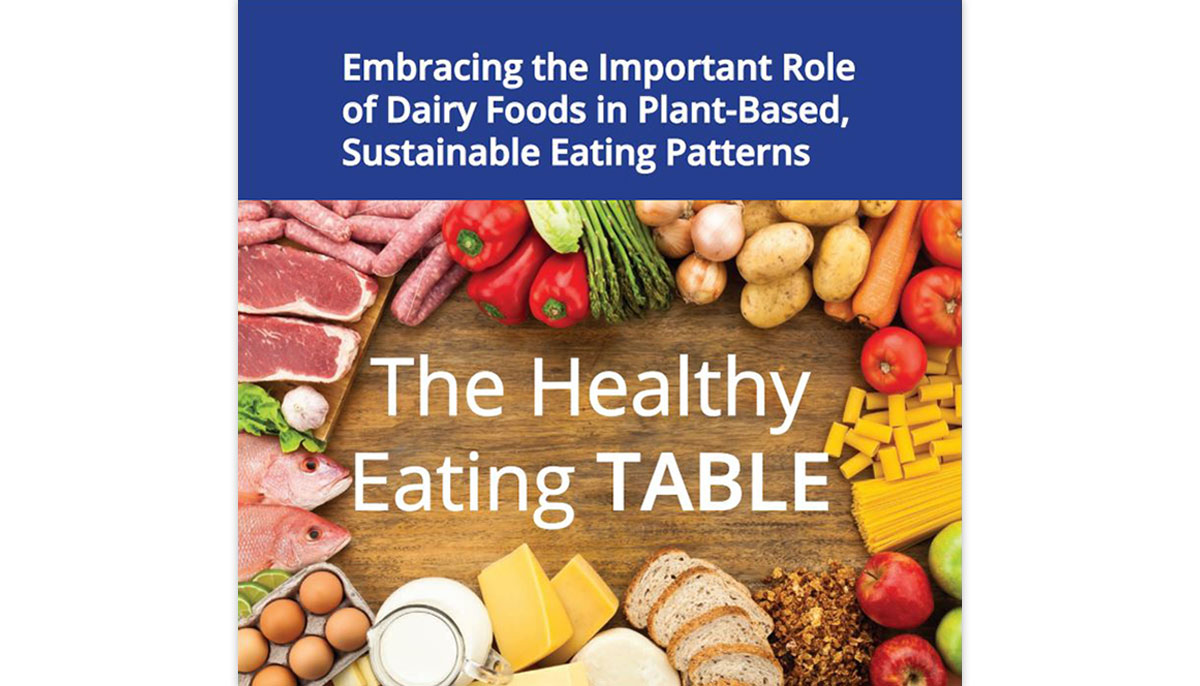The 2019 TABLE publication summarizes how to prioritize the nutritional needs of children to support optimal growth, development and lifelong health.

By: Kristal Shelden, MPH, RDN and Ashley Rosales, RDN
Dairy Council of California’s nutrition sciences team collects, analyzes and communicates the latest research and data on nutrition education and healthy eating patterns. This publication is intended to be a tool to increase knowledge, effectiveness and capacity for collective action in making healthy eating easier.
The rising rate of obesity coupled with related chronic disease is a public health crisis impacting the lives of adults and, increasingly, children.1 Mitigating the devastating effects of chronic disease requires the collective action of multiple sectors working together to inspire changes in systems and community environments as well as individual behavior.
Along with obesity and chronic disease is the interrelated issue of food insecurity, a reminder that solving complex public health problems requires a broad range of solutions and a zealous application of credible science. It is with that notion that nutrition recommendations and healthy eating guidance can be viewed through the lens of whole foods and, ultimately, healthy eating patterns as the optimal way to obtain nutritional adequacy while supporting the health of both people and planet.
Nutrition experts agree that overall diet quality matters more than calories or single nutrient amounts.2 In nature, nothing happens in isolation, and the nutrients within a food work together to impact biological pathways leading to positive health outcomes. Foods also interact with one another in unique ways. When certain foods are eaten together, their nutritional benefits are amplified. For example, once probiotic-rich fermented foods like yogurt and kefir are eaten, the beneficial bacteria feed off prebiotics from fiber-rich foods in the gut. Therefore, pairing yogurt with fruit or whole grains enhances the benefits of the probiotics. This is referred to as food synergy. Whole foods as well as combinations of whole foods eaten together are greater than the sum of their parts, which is why an overall healthy eating pattern is important.3
Based on the available science, it may be overly simplistic to point to a single macro- or micronutrient as the cause of a chronic disease or poor health outcome. Although individual nutrients are important, it should be recognized that health benefits are optimized because of synergistic effects of dietary patterns with multiple whole foods. Accordingly, any assessment of an eating pattern’s impact on health should go beyond the quantity of individual nutrients to also include the quality of foods and how they influence metabolic pathways.
Dairy foods offer health attributes that are different from plant-based foods and other animal-source foods; dairy plays an integral role in supporting overall health. Especially for young children and adolescents, dairy food consumption is essential in optimal growth and development. The three eating patterns recommended by the Dietary Guidelines for Americans emphasize a variety of plant-based foods but also include dairy in order to meet nutritional needs and reduce risk for chronic diseases. While the recommendations are clear, many Americans are under-consuming vegetables, fruits and dairy, resulting in nutrient gaps.2 Encouraging consumption of nutrient-dense foods, both from plant-based and dairy sources, can help close the nutrient gaps that exist for Americans of all ages.

For decades, dietary recommendations have focused on limiting high-fat intake on the basis that it leads to obesity, heart disease, diabetes and many other chronic diseases that plague the United States. As a result, many Americans adopted low-fat dietary patterns, yet chronic disease rates continued to grow at alarming rates.4 Medical and nutrition experts are beginning to understand that not all dietary fats are equal, and certain foods containing saturated fat may not be as directly linked to cardiovascular disease (CVD) risk as previously thought. Furthermore, research is finding the links between dairy foods and health outcomes may be different than other foods that contain saturated fat.5
Emerging research suggests that saturated fat consumption on its own is an insufficient metric for diet quality. Different food sources of fat can contribute additional nutrients and bioactive compounds to the diet that may impact disease risk.6 Whole foods consist of numerous nutrients that are contained in a complex structure. These nutrients often interact in unique ways to impact various biological processes. The nature of the food structure and the nutrients there-in—the food matrix—may impact health indicators differently when compared to single nutrients studied in isolation.
More specifically, the nutritional values of dairy products should be considered on the basis of the biofunctionality of the nutrients within dairy food structures rather than on nutrient content alone.7 There is a growing body of evidence that links the consumption of milk and dairy foods to a wide range of health benefits, from well-studied associations like controlling blood pressure and improving bone health to newer associations like reducing the risk of diabetes and heart disease.8 Future research will continue to help provide a better understanding of the dairy matrix and the different nutrient delivery mechanisms and their impact on health.
Over the past decade, prospective and intervention studies, meta-analyses and systematic reviews have demonstrated that milk, cheese and yogurt consumption, regardless of fat content, is not associated with increased risk for CVD and other chronic diseases. A recent study published in The Lancet that followed over 136,000 adults across 21 countries linked consumption of dairy with a reduced risk of major cardiovascular disease and stroke.9 An additional randomized controlled trial found that regular (full-fat) dairy food consumption improves lipid biomarkers related to risk for CVD.10These findings add to the growing body of evidence that regular dairy food consumption—at all fat levels—may be linked to neutral or reduced risk of developing CVD.
With strong consensus from a growing number of studies, the evidence supports the need to reaffirm the role of whole and reduced-fat dairy foods in healthy eating patterns. This effort is critical to ensure that future nutrition guidance continues to embrace dairy foods as an important part of healthy eating patterns that promote optimal health and reduce chronic disease. Recommendations that do not acknowledge the unique package of nutrients and health-promoting benefits that milk, yogurt and cheese provide as part of healthy eating patterns could result in missed opportunity for optimal nutrition.
More than ever before, the discourse around dietary recommendations that optimize health is becoming inextricably linked with sustainability. With sustainable nutrition as an important goal, the agriculture, food systems and health sectors can continue to use advances in science, innovation and technology to become more efficient and sustainable while making nutritious foods available for all. The dairy agricultural community has been a leader in developing and implementing technologies that have lessened the environmental impact of producing and processing nutrient-dense dairy products. During the past 70 years, dairy community efforts have led to a 90% decrease in land use, 63% decrease in greenhouse gas emissions and 65% decrease in water needed to produce the same amount of milk (from 1944–2007).11
Sustainable nutrition is a topic with international importance, as countries around the world are faced with addressing the triple burden of malnutrition, obesity and micronutrient deficiencies while protecting finite natural resources. This is one reason the United Nations launched the Sustainable Development Goals with the global aim of drastically decreasing poverty, hunger, climate change and inequality by 2030.12 Within these goals is a focus to end hunger, improve health and well-being and promote sustainable agriculture. At every level, health and sustainable food systems are linked. Moving into the future, it is inevitable that nutrition recommendations and guidelines will integrate sustainability.
Compelling evidence links food insecurity to poor health outcomes, heightening the urgency to seek solutions. With many children and adolescents being overweight and undernourished, access to nutritious and wholesome foods as well as nutrition education is essential to help children reach their full health potential as adults. Recommendations put forward to improve healthy eating serve as a catalyst for public policy that may ultimately determine the food choices available to the most vulnerable populations through nutrition assistance programs. One example of this critical safety net is school meal programs. Research suggests that eating school breakfast every day is associated with healthier dietary intakes among US schoolchildren, particularly increased intakes of vegetables, fruits, whole grains and dairy.13 In addition to improving overall nutrient intake, consumption specifically of vegetables, fruits or dairy products made readily available in school meal programs is associated with improved academic and health outcomes among children and adolescents.14
Sustaining the environment is critical; equally important is addressing the inequities of food affordability, access and availability in food system models. Dietary recommendations and food policy should not be solely based on the environmental dimension of sustainability and should be carefully formed. Economics, nutrition, culture and other sociological factors must be considered in relevant policies when planning ways to feed the growing population. A multidimensional approach is necessary to build resilient, sustainable food systems that support healthy communities. This concept is reinforced by the recent release of the Lancet Commission on Obesity report, The Global Syndemic of Obesity, Undernutrition, and Climate Change, which states that synergistic actions will be essential to achieve planetary health, defined as the health and well-being of humans and the natural environments they depend on.15
Policy that endeavors to improve the health of people and planet should be carefully and thoughtfully implemented and acknowledge the unique nutritional, economic and social contributions that dairy foods and agriculture make. Dietary recommendations and guidelines for the public that restrict single nutrients or food components such as saturated fat or animal protein without focusing on the whole food matrix, healthy eating patterns or the many factors of sustainability could unintentionally limit access to and consumption of nutritious foods like milk and dairy foods, which nourish people worldwide. Evidence confirms the important role of dairy foods in healthy eating patterns that are associated with reduced risk of cardiovascular disease, type 2 diabetes and obesity.8 Food insecurity, especially with vulnerable populations such as young children, requires collective efforts that ensure access to nutrient-dense foods that support optimal growth and development. With rates of non-communicable disease and associated health care costs rising globally,15 ensuring that nutrition guidance is evidenced based and embraces all dimensions of sustainability will help foster optimal health and greater access to nutritious foods in communities where people live, learn, work and play.